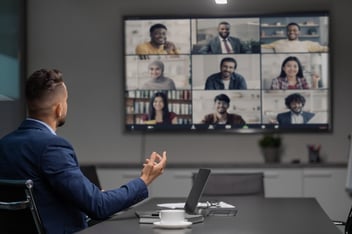Communication is one of the most important aspects of any business relationship. Whether you're working with a developer, supplier, or even a customer, effective communication is vital to ensuring that everyone involved in your project understands each other's needs and expectations. Let's take a look at how to communicate effectively with developers.
Keys to effective communication
Effective communication is a skill that can be learned and improved over time. Here are some key principles to keep in mind.
Clarity: The message should be clear, concise, and easily understood by the recipient. Avoid using technical jargon or complex language that may be unfamiliar to the listener.
Active Listening: Effective communication involves listening attentively and giving full attention to the other person's message, seeking to understand their point of view, and responding appropriately. Positive body language can help demonstrate your active listening.
Empathy: Take the other person's perspective into account, be aware of their feelings, and show a genuine interest in their needs and concerns. It’s important to see things from another person’s perspective.
Respect: Respect for the other person's opinion and feelings is also essential to effective communication. People are more likely to listen and positively respond when they feel respected.
Timeliness: Timely communication is crucial, especially when working on a project with deadlines. Prompt and timely communication can prevent misunderstandings and keep everyone on the same page.
Feedback: Feedback is essential for improving communication. Feedback helps ensure that messages are understood and that any misunderstandings are addressed promptly. It's necessary to approach feedback with an open mind and a willingness to learn and grow.
Consistency: Consistency helps to build trust and establish expectations. Consistent communication also helps to alert everyone of any changes or updates to the project.
Communication style: Different situations call for different communication styles. For example, a formal presentation may require a more structured and polished approach, while a one-on-one conversation may allow for a more informal and conversational tone. It's important to consider the context and audience when communicating with others.
By keeping these principles in mind, you can improve your communication skills and build stronger relationships with your colleagues and team members. Effective communication is a key ingredient for success in any field, and it can be the difference between a successful project and one that falls short.
Barriers to effective communication
Several barriers can prevent successful communication from taking place. These include:
Language barriers: When communicating with individuals who speak a different language, language barriers can make it difficult to understand and convey information effectively. Remember that even if you speak the same language as another person, they may have different knowledge of the specific slang, jargon, or figurative language you use, so avoid using terms that may be unfamiliar to others.
Cultural barriers: Cultural differences can lead to misunderstandings and misinterpretations, making it challenging to communicate effectively. Remember that even some basic gestures common in your culture could be perceived as negative body language or downright offensive in other cultures.
Physical barriers: Physical barriers can hinder effective communication. For example, working in separate locations, a noisy work environment, or having limited access to the right tools can challenge effective communication.
Emotional barriers: Emotions can interfere with communication. Individuals may feel angry, frustrated, or anxious, impacting their ability to listen and respond to others.
Technological barriers: Technology can facilitate communication but also present barriers. Technical difficulties or being away from your device can prevent effective communication.
Perception barriers: Perception barriers occur when individuals interpret messages differently. This can lead to misunderstandings and misinterpretations.
Attitude barriers: Attitudes and biases can also hinder effective communication. For example, if someone is not open to new ideas or approaches, they may not be receptive to others' opinions or feedback.
Lack of clarity: When a message is unclear or poorly expressed, it can lead to misunderstandings and confusion. This happens when a speaker is not precise with their language or assumes that the listener has the same level of knowledge and understanding.
Lack of context: Communication can break down when the listener does not have the necessary context to understand the message. Suppose a project manager gives instructions without providing background information or explaining the purpose of the task. In that case, the developer may not understand why the task is important or how it fits into the broader project.
Distractions: Communication can be disrupted when there are distractions, such as noise, interruptions, or competing priorities. These distractions can make concentrating and focusing on the conversation difficult, leading to misunderstandings or missed information.
Timing: Timing is essential in communication. If a message is delivered at the wrong time or in the wrong way, it can be ineffective or damaging. For example, delivering bad news at the end of a long workday may not be the best timing, as the recipient may be too exhausted to process the information effectively.
Power dynamics: Power dynamics can also be a barrier to effective communication. When one person has more power or influence than another, it can be difficult for the less powerful person to express their ideas or opinions openly and honestly. This can lead to communication breakdowns and missed opportunities for collaboration and innovation.
Identifying and overcoming these barriers is essential for effective communication. Overcoming barriers requires being aware of them, making an effort to understand others' perspectives, and working collaboratively to find solutions. By recognizing these barriers and working to overcome them, you can improve communication and increase the likelihood of achieving successful outcomes.
How to communicate effectively with software developers
Communicating effectively with software developers is crucial to ensuring your project requirements are understood and executed correctly. Here are some tips on how to do so:
- Start with a clear and concise explanation of the project requirements. Use simple language and avoid technical jargon.
- Use visual aids like diagrams, flowcharts, and wireframes to help illustrate your requirements. This allows the developer better understand the project's scope and what you're trying to achieve.
- Be specific about what you need and why you need it. Give the developer context and explain the purpose behind each requirement. This can help them make more informed decisions during the development process.
- Establish open lines of communication from the start. Ensure the developer knows they can come to you with questions or concerns throughout the project. Encourage them to ask questions and provide regular updates on their progress.
- Use collaborative tools like project management software or version control systems to keep everyone on the same page. This will streamline communication and ensure everyone is working towards the same goals.
Remember, effective communication is a two-way street. Be willing to listen to the developer's ideas and suggestions, and be open to feedback on your requirements. By working together, you can ensure that your project is a success.
The importance of effective communication for software development projects
Effective communication is critical for the success of any software development project. Your ability to communicate effectively with your developers is essential if you want them to deliver quality work that meets your requirements. You need to give a clear idea of what the finished product should look like and provide feedback on the developer's work.
One key is to establish precise specifications from the beginning. By providing a detailed and accurate description of what is being built, including any technical specifications or functional requirements, you keep your developers working towards a clear goal.
Establishing a shared understanding of project goals and objectives is also important. Developers need to understand why the project is happening, what problem it is intended to solve, and how it fits into the broader strategic objectives of the organization.
Defining success or failure criteria for the project is also essential. This means establishing clear benchmarks for measuring progress and determining whether the project has succeeded. With clear goals in place, it can be easier for developers to know whether they are on track to meet project objectives.
Finally, effective communication requires understanding the roles and responsibilities of all stakeholders involved in the project. This includes identifying the various teams, individuals, and departments involved and their respective roles and responsibilities. This keeps everyone aligned and working towards the same goals.
What a developer needs to know: process for gathering software requirements
Remember that developers aren't mind readers; if there's something you want them to know about your project or company culture, be sure to tell them directly! Whether you're looking to hire remote developers, freelance developers, or a development company. Let’s go over some basics for gathering project requirement information.
What is the overall goal of your project?
The overall goal of your project is the guiding principle that will drive all decisions related to the project's scope, budget, and timeline. Understanding the overarching goal is critical to the project's success, and it's important to communicate this goal clearly to all stakeholders, including the software developer.
Let’s look at the two most important questions to answer before diving into hiring a developer or team.
What exactly do you want to develop? Before you can set the goal for your project, you need to clearly understand what you will be developing. Is it a mobile app, a website, or something else? What problem does it need to solve? What platforms and technologies will you use? These decisions will impact the project's scope and help guide your software developers.
What features would be most important for the application to have? Once you've identified what you want to develop, it's important to consider the features that will be most important. These features should align with the needs of your stakeholders and end users and should be prioritized based on their importance. This will help ensure that the developers focus on building the most critical features first and can make effective decisions as the project progresses.
By setting a clear overall goal for your project, you can be confident that all stakeholders are aligned on the project's direction and objectives and can make effective decisions related to scope, budget, and timeline. This will help the project succeed and meet the needs of its stakeholders and end users.
Who are the stakeholders involved?
Identifying and engaging with stakeholders is another critical step in gathering requirements. Stakeholders may include your organization's end users, management, and other departments. It's essential to involve these stakeholders in the project from the beginning, as their input can help to shape the project's direction and ensure that it meets their needs.
In addition to end users and management, several other teams and departments within the organization could be stakeholders. These may include marketing, sales, customer service, legal, and finance. Each team may have requirements, needs, and expectations from the project.
It's important to identify all the stakeholders involved in the project and understand their unique requirements and perspectives. This will align the project with the organization's needs, not just a specific team or department.
In addition to internal stakeholders, external stakeholders such as customers, vendors, or partners may impact the project. These stakeholders should also be identified and engaged with to consider their needs.
Engaging with stakeholders early in the project can also help build buy-in and support. Communicating with stakeholders regularly throughout the project keeps them informed of progress and gets their feedback on important decisions.
How will you share information with developers?
Clear and effective communication with the developers is essential to the project's success. Consider setting up regular meetings or check-ins, and establish a communication plan outlining the tools and methods for sharing information.
In addition to setting up regular meetings or check-ins with the development team, there are various tools, technologies, and channels can be used to facilitate communication throughout the project. The communication plan should identify the specific tools and technologies used for different types of communication, such as:
- Email: Email is a common tool for sharing information such as project updates, status reports, and meeting agendas.
- Instant messaging: Instant messaging tools such as Slack or Microsoft Teams can be used for real-time communication and can be very effective when dealing with remote developers.
- Project management tools: Tools such as Jira or Trello can be used to track project progress and share updates with the development team.
- Video conferencing: Video conferencing tools such as Zoom or Teams can be used for remote meetings or face-to-face communication with team members in different geographic locations. This has become an essential tool for remote developers and others who work remotely.
- Shared document repositories: Tools such as Google Drive or SharePoint can be used to share documentation.
Establish a clear communication plan outlining the tools and technologies used for different types of communication and the frequency and format of communication. Create a schedule for regular meetings or check-ins and include contingency plans for addressing communication breakdowns or issues that may arise during the project. The plan should also identify the roles and responsibilities of team members in facilitating communication and keeping everyone informed and up-to-date.
What is the timeline?
Setting a project timeline is crucial to managing any software development project. The timeline should consider the project's size, complexity, and availability of resources, including the development team and any external vendors or partners. An accurate time estimate is also needed to set a project budget.
A practical approach to setting a timeline is to break the project down into smaller milestones or phases (often called sprints), each with its own set of objectives and deadlines. This allows you to track progress more effectively and keep the project on track.
In addition to setting a timeline, it's also essential to communicate it clearly to all stakeholders, including the development team. This helps manage expectations and ensure everyone is on the same page regarding project deadlines and deliverables. Don’t forget to factor in buffer room for unexpected delays, technical issues, or changes in requirements and establish a plan to deal with these potential challenges.
Consider the tools and technologies you’ll use to track progress and communicate updates. This may include project management software, collaboration tools, and communication channels such as email or chat applications. Selecting the right tools and technologies for your project ensures that communication remains clear and effective throughout development.
How to hire a developer with excellent communication skills
Now you might be thinking this is all great, but how do I hire a developer in the first place? If you're looking to hire developers, go to Talentcrowd to get experienced remote developers for any project. They have excellent communication skills, are experts in their fields, and will create anything you can imagine. We've worked with small businesses and top companies in the industry. We believe in the future of remote work, and our freelance developers are available for any job you can throw at them.




